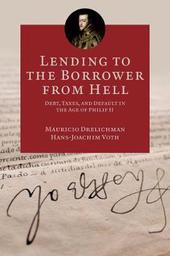
|
Lending to the Borrower from Hell: Debt, Taxes, and Default in the Age of Philip II
Hardback
Main Details
| Title |
Lending to the Borrower from Hell: Debt, Taxes, and Default in the Age of Philip II
|
| Authors and Contributors |
By (author) Mauricio Drelichman
|
|
By (author) Hans-Joachim Voth
|
| Series | The Princeton Economic History of the Western World |
|---|
| Physical Properties |
| Format:Hardback | | Pages:328 | | Dimensions(mm): Height 235,Width 152 |
|
| Category/Genre | Economic history
Credit and credit institutions |
|---|
| ISBN/Barcode |
9780691151496
|
| Classifications | Dewey:330.946043 |
|---|
| Audience | | Tertiary Education (US: College) | | Professional & Vocational | |
|---|
| Illustrations |
4 halftones. 32 line illus. 29 tables.
|
|
Publishing Details |
| Publisher |
Princeton University Press
|
| Imprint |
Princeton University Press
|
| Publication Date |
19 January 2014 |
| Publication Country |
United States
|
Description
Why do lenders time and again loan money to sovereign borrowers who promptly go bankrupt? When can this type of lending work? As the United States and many European nations struggle with mountains of debt, historical precedents can offer valuable insights. Lending to the Borrower from Hell looks at one famous case--the debts and defaults of Philip II of Spain. Ruling over one of the largest and most powerful empires in history, King Philip defaulted four times. Yet he never lost access to capital markets and could borrow again within a year or two of each default. Exploring the shrewd reasoning of the lenders who continued to offer money, Mauricio Drelichman and Hans-Joachim Voth analyze the lessons from this important historical example. Using detailed new evidence collected from sixteenth-century archives, Drelichman and Voth examine the incentives and returns of lenders. They provide powerful evidence that in the right situations, lenders not only survive despite defaults--they thrive. Drelichman and Voth also demonstrate that debt markets cope well, despite massive fluctuations in expenditure and revenue, when lending functions like insurance. The authors unearth unique sixteenth-century loan contracts that offered highly effective risk sharing between the king and his lenders, with payment obligations reduced in bad times. A fascinating story of finance and empire, Lending to the Borrower from Hell offers an intelligent model for keeping economies safe in times of sovereign debt crises and defaults.
Author Biography
Mauricio Drelichman is associate professor in the Vancouver School of Economics at the University of British Columbia and a fellow in the Institutions, Organizations, and Growth program of the Canadian Institute for Advanced Research. Hans-Joachim Voth is ICREA Research Professor in the Economics Department at Universitat Pompeu Fabra, Barcelona, where he is also a member of the Centre for Research in International Economics. He is the author of "Time and Work in England during the Industrial Revolution" and coauthor of "Prometheus Shackled".
Reviews"A thoroughly enjoyable economic history book with great relevance for the present debate on sovereign borrowing."--Diane Coyle, Enlightened Economist "Lending to the Borrower from Hell is a wonderful example of what becomes possible when one takes economic theory on a trip to the archive and actually reads the small print of each contract. It provides for the first time an economically sound explanation for Spain's ability to borrow in the sixteenth century that actually fits the facts. That is an outstanding achievement."--Regina Grafe, EH.Net "[T]his innovative monograph substantially enriches our understanding of Castile's government borrowing, as well as the nature of sovereign default in early modern Europe. And it will most certainly conquer a central place in the literature and future debates on public debt and finance from a historical perspective."--Benoit Marechaux, CritCom "Intensely researched."--Elvira Vilches, Renaissance Quarterly
|